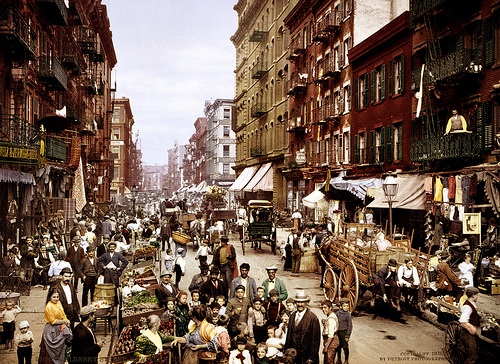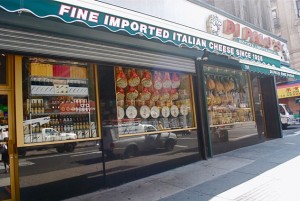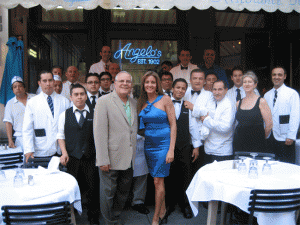 On May 31, 2010 – I was contacted by: John Mariani regarding my post about Little Italy
On May 31, 2010 – I was contacted by: John Mariani regarding my post about Little Italy
“Franco, this is a heartfelt fine article. Would you mind if I published it on my Virtual Gourmet this summer? John”
Mr. Mariani is the author of several excellent cookbooks and the founder of Virtual Gourmet an online weekly culinary publication. www.johnmariani.com
To be a guest writer on –MARIANI’S VIRTUAL GOURMET NEWSLETTER /Volume VIII, was a honor and greatly appreciated by me. http://www.johnmariani.com/current-issue
Below is the Article that Mr. Mariani published on his weekly NEWSLETTER on Aug. 8, 2010
NEW YORK CORNER
Whatever Happened to Little Italy? by Franco Lania
Little Italy was once a vibrant neighborhood where good food and charming restaurants were abundant. Now, except for a few old timers like Di Paolo’s Fine Foods and Alleva Dairy, Ferrara’s Pastry, and remnants of days when tourists and New Yorkers flocked here for a true sense of history, there is little left that is not more hype than substance. Guest writer chef-restaurateur Franco Lania tries to explain what happened.–John Mariani
Many people have asked me what do I think happened to poor Little Italy? Why has it deteriorated so much? Since I live only blocks away from the neighborhood, and once worked as a chef in Little Italy, what do I feel caused the deterioration of that once great neighborhood?
Having family myself that came from Italy to the United States via Little Italy back in the first half of the 1920’s, I can say that upward mobile flight by the children of the immigrants began the demise of the neighborhood. I grew up hearing stories from time to time about how beautiful Little Italy was, what a fun place it was, how the food and feasts were always something to look forward to!
This is a far cry from today’s Little Italy. The feast of San Gennaro is pretty much the only street fair left in Little Italy and is always in controversy with the city over if it could continue or not. The food in Little Italy has a poor reputation and the foodie people of NYC typically avoid the area because of this poor food reputation and tourist crowds.The Italian specialty shops are pretty much nonexistent and the few that are left are not enough to help uplift the neighborhood. The best and most reliable draws for good food in Little Italy are Angelo’s (opened in 1902) and Il Cortile, two restaurants that are still excellent but frequented pretty much by the bridge-and-tunnel crowds from outside of the city. The tourists usually meander up Mulberry Street looking for a quick bite and a cheap deal, as they make their way to their real places of interest, Soho and NoLita. Catering to the tourist crowd instead of New Yorkers is one of the main downfalls of Little Italy.
In a nutshell this is what happened. Little Italy was a neighborhood based on immigrants who came from Italy starting in the late 1800s and early 1900s. These early Italians had a safe haven in a city and country they knew nothing, and few could speak, read or write English. Most of the first wave of immigrants never really assimilated into the city or America for that matter and in not doing so kept Little Italy very much alive and thriving for years. The comfort of being able to communicate in their own language and to stay close and near to the people and customs they could relate to was a huge factor in their not leaving the neighborhood.
Angelo’s of Mulberry St.
Time moved on and eventually the first and second-generation children of these immigrants become educated and assimilated into NYC, and become Americanized, wanting more than Little Italy has to offer them. These now Italian-Americans left the neighborhood in search of their fame and fortune outside the old neighborhood and entered into the American Dream. Eventually over time the only ones left are the old timers and the few families that never left.
The ones left behind can’t maintain and keep the vibrancy of the neighborhood alive, so it changes and goes on its ever downward spiral. The people who left the neighborhood and made successes of their lives far beyond the dreams of their parents or grandparents never seem to get involved in the now old neighborhood and show an interest in the preservation or gentrification of it.“Italian-Americans must unite to change what has happened to New York’s-Little Italy. It’s not to late. With unification and determination Little Italy could be uplifted and given an “Italian Cultural Renaissance” that it so deserves! It needs empowerment by the City of New York, or else New Yorker’s and Italian Americans alike won’t have a Little Italy to even write about! ”
At this point Little Italy is like a mother that gives and gives and never receives anything back in return from her children. Eventually she becomes old, run down and tired!


